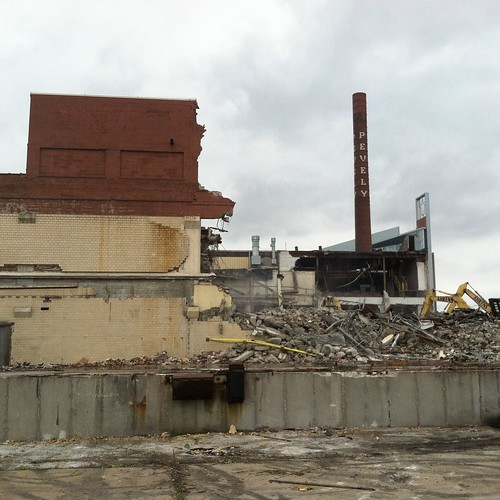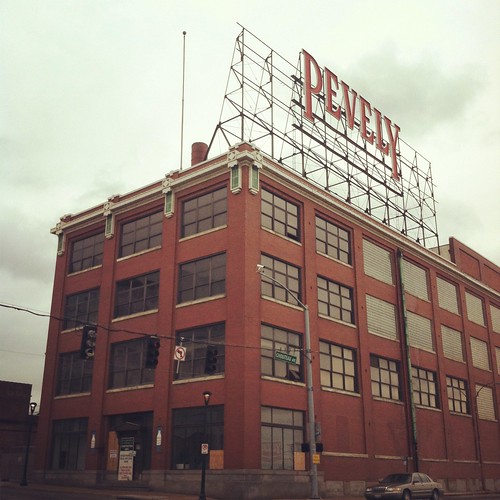by Michael R. Allen

At the start of April, St. Louis University started demolishing the Pevely Dairy plant at Grand and Chouteau avenues. Last month, the Planning Commission overturned a series of Preservation Board decisions about applications to demolish components of the complex. The result of the Planning Commission decisions was the immediate approval of demolition of every part of the plant save the landmark corner office building, which can be demolished once the university secures a building permit for its new ambulatory care center.

Upon completion of demolition, the only building to remain at one of south city’s busiest intersections will be the esteemed work of Nautical Revival architecture, the Captain D’s franchise at the northwest corner of the intersection. Urbanists who proclaimed that removal of the Pevely plant would rob the intersection of urban character stand in the wrong.

Let us not forget to thank the Planning Commission’s members for wise and world-class judgment.

21 replies on “Pevely Dairy Plant Demolition Underway; Captain D’s Preserved”
Progess.
Michael, you have to have managed decline. This is what management looks like. At least this is what post-industrial American management looks like.Â
Or as I like to call it: Sustainable decline.
correction: this is what POOR management looks like. unnecessary demolition is waste, not management.
 I don’t disagree, but I think that de-densification of the light-rail served core is a horrible strategy of managed decline.
So it doesnt matter if a building is slanted as a historic landmark. How much money do i need to give the city to be able totear down The Gateway Arch.
Managed decline, smart decline, shrinkage.
These are all ways to dress up the fact that neoliberal polices have failed our cities.
Of course this unproven theory of managed decline has nothing to do with this demolition.Â
The building was going to be housing and in any rational world where land use hasn’t been given over to a dictator, who directly threatened St. Louis City voters, that outcome would have occurred. Â
Biondi’s suburbanization of Midtown has impeded all efforts at reinvestment for decades. Â
 What’s sustainable about more demolition in the core while the fringes sprawl, consuming more resources, polluting our air, and emitting carbon? This theory is bullshit. Â
Nautical Revival. Did you file a NR nomination yet?
 “…the fringes sprawl, consuming more resources, polluting our air, and emitting carbon?” Excellent point, and all the while making our Nation the most energy-inefficient country on the planet. Europe may not have the most robust supplies of readily convertible hydrocarbons, besides coal, and a dwindling amount of North Sea crude, but they are significantly more efficient, and–ironically–conservative with what they’ve got. Hell, the Germans have been trying over the last ten years or so to get even more efficient, lest they continue to be Gazprom’s (Russia’s) bitch.
Sustainable decline–sounds like a combination of both “New Urbanism” and Third Way BS.
As you have already noted, Mr. Duckworth, the wasted area around Midtown, and the failed industrial policies (were there any successful ones, post-WWII?) of the United States, can be laid, at least in part (See Ponzi scheme, Wall St., and automation/outsourcing, for further clues), to the neoliberal economic policies promoted by the US (Fed), the IMF, and the World Bank. Oh, and of course, that egomaniac, Il Duce.
Oh, man, “world-class”. Brings to mind the heady days of the Schoemehl administration: “world-class” this, and “world-class” that, here a “world-class”, there a “world-class”, everywhere a “world-class”.
Nice bit of snark, Mr. Allen.
I think I made the incorrect decision to stay in the STL lo those many years ago. Bravo to Mr. Duckworth–and others–on escaping the asylum. Â
Very good points.
Academics and practitioners argue that smart decline, or whatever they call it as the name changes, should be how cities proceed.  These places have been demolishing buildings for decades.  Look at St. Louis’ urban renewal projects.  Look at the areas that were planned for divestment.  The former did not prevent decentralization and the latter made the problem worse.  The growth machine in regions like Saint Louis still operates, however perverse public policies and discriminatory private outcomes moved it outward from the core.  These structures remain in place today rendering the core hamstrung by the absence of re-distributive aid and the presence of hostile neighbors. Â
Neoliberalism in this case would mean the devolution of responsibility and near abandonment of cities on the federal agenda.  Of course public choice theory (Tiebout et al), laid the groundwork arguing this is a entirely rational outcome.  If anything cities need an activist state willing to use carrots and sticks to correct the mistakes initiated during the post-war period.  If this does not happen many more places will continue their decline.  Expecting cities with limited capacity like Saint Louis to compete globally — and locally — should be considered Social Darwinism.  Is this how civil society should operate?   Â
Everyone knows Saint Louis can be extorted because of its position.  Biondi is no fool.  Planners who argue for managed or smart decline reinforce that structure, when they should be advocating for a revolution in how our nation treats cities at the local, regional, state, and federal scales.   Until that happens we will continue to see charter schools rather than regional unified school districts, demolition rather than rehabilitation, sprawl not urban growth boundaries, reverence to the private sector rather than objectivity, and charlatan consultants selling their snake oil solutions.
I didn’t realize that you guys actually thought that managed decline was something that should be considered credible. I was using it as a sarcastic line.
Any politician who utters it is basically admitting that he has neither the power or political sklll to fix or regenerate the community he governs. Good politicians seek political trades that solve problems; bad ones find rationalizations as to why you should reelect them.
Smart decline is all over planning literature and on the minds of practitioners. I apologize if I went off.
Is there a picture showing the intersection, including the Captain D’s? I want to see how the fabric of the neighborhood is sustained by the continued presence of this landmark. Nautical Revival, you say? I gotta study up on that style…
 Considering that there are a number of “respectable” sources and pundits which advocate for managed decline, in precisely the same language you’ve spoken with, it’s not too surprising that my snark meter didn’t catch your sarcastic tone.
It’s rather disheartening to see the decline of leadership at every level of government, industry, and commercial enterprise. And our country (and planet, for that matter) is suffering for it.
I take away 5 points
1. Preservation means nothing now, why would anyone obey those laws unless they want tax credits. It has gutted the meaning of preservation.
2. The fact the new building is suburban in design completely negates the considerable investment in the adjacent light rail. It is an issue of preserving old city patterns also. It is a travesty that City government failed here to include those considerations.
3. The silence of supposedly transit orientated agencies, East West Gateway Council, Metro and the non profit Citizens for a Modern Transit is only more proof how bankrupt the government is in its actions.
4. Until this demolition I actually thought St. Louis was progressing, now I think it is on its last gasp of living off its past. What is it, 60 years of decline? The same attitudes, the same who cares insider back slapping, the same degenerate leadership is still in power and still causing the decline of St. Louis. We see it with our own eyes here, today.
5. I feel like the people, the citizens, have to take control of the situation.
 @ #5: Sadly, it would seem that most of our fellow STL’ans just love their alderman. It’s your alderman that’s the problem, if you get my meaning. Craig, Fred, Joe, et al, throw the plebes a bone–a useless stop sign here, a wasteful alley paving there, a cleaned-up alley, an easement tree, etc., and you’d think the morons had moved a mountain. Don’t get me started on the idiots who’ve occupied R200 over the last seventy years. Not to mention we had a chance to begincharter reform–just a beginning, mind you, just a roadmap, and it got shot down. A little stoopid, it would seem, goes a long way.
 You are right, but then it maybe says the citizens write their own planning laws. Forexample along the lines of the London Unitary Plan(since renamed) which established strategic goals for all of city planning. It could be duplicated online and create an alternative to current city policy. Better ideas will win in the end, right now they are suppressed by monolithic policies encouraged the media, government and large corporate interests.
Ultimately stupid fails. Stoopid too.
So sad, my Dad used to take me there when I was a little girl, he delivered milk from farmers for over 40 years.
“nautical revival” lol. At least the rally.s American graffiti pseudo drive in revival serves ice cream for a dollar.